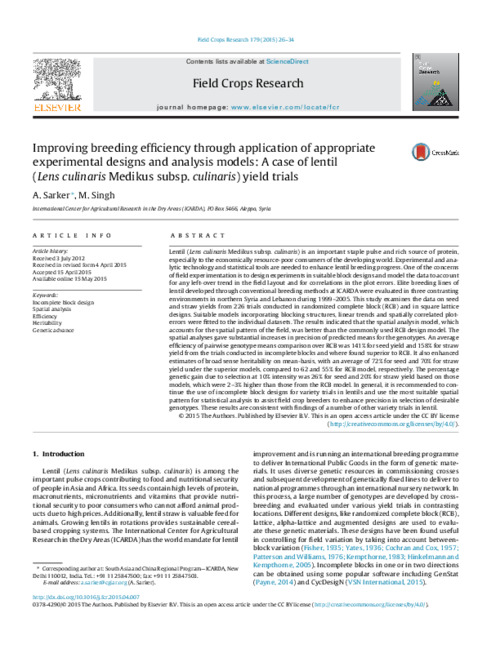Improving breeding efficiency through application of appropriate experimental designs and analysis models: A case of lentil (Lens culinaris Medikus subsp. culinaris) yield trials
Abstract
Lentil (Lens culinaris Medikus subsp. culinaris) is an important staple pulse and rich source of protein, especially to the economically resource-poor consumers of the developing world. Experimental and analytic technology and statistical tools are needed to enhance lentil breeding progress. One of the concerns of field experimentation is to design experiments in suitable block designs and model the data to account for any left-over trend in the field layout and for correlations in the plot errors. Elite breeding lines of lentil developed through conventional breeding methods at ICARDA were evaluated in three contrasting environments in northern Syria and Lebanon during 1999–2005. This study examines the data on seed and straw yields from 226 trials conducted in randomized complete block (RCB) and in square lattice designs. Suitable models incorporating blocking structures, linear trends and spatially correlated plot-errors were fitted to the individual datasets. The results indicated that the spatial analysis model, which accounts for the spatial pattern of the field, was better than the commonly used RCB design model. The spatial analyses gave substantial increases in precision of predicted means for the genotypes. An average efficiency of pairwise genotype means comparison over RCB was 141% for seed yield and 158% for straw yield from the trials conducted in incomplete blocks and where found superior to RCB. It also enhanced estimates of broad sense heritability on mean-basis, with an average of 72% for seed and 70% for straw yield under the superior models, compared to 62 and 55% for RCB model, respectively. The percentage genetic gain due to selection at 10% intensity was 26% for seed and 20% for straw yield based on those models, which were 2–3% higher than those from the RCB model. In general, it is recommended to continue the use of incomplete block designs for variety trials in lentils and use the most suitable spatial pattern for statistical analysis to assist field crop breeders to enhance precision in selection of desirable genotypes. These results are consistent with findings of a number of other variety trials in lentil

